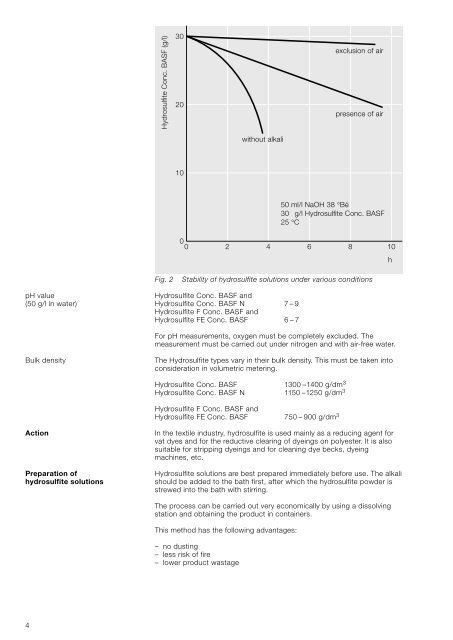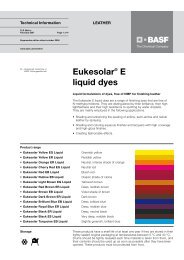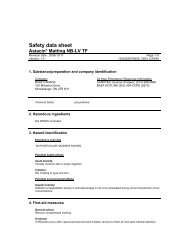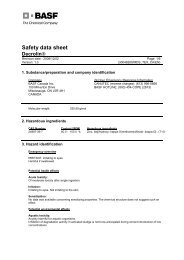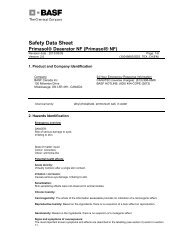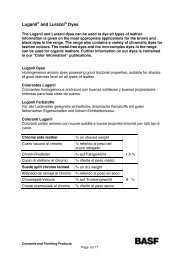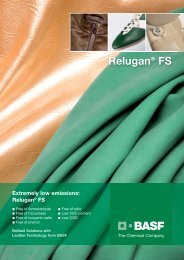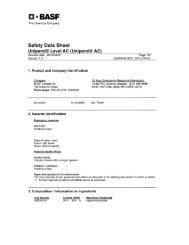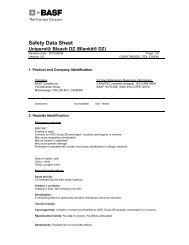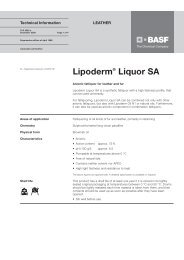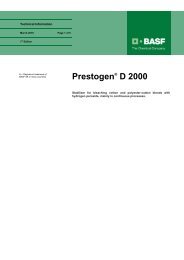Hydrosulfite Types - BASF
Hydrosulfite Types - BASF
Hydrosulfite Types - BASF
You also want an ePaper? Increase the reach of your titles
YUMPU automatically turns print PDFs into web optimized ePapers that Google loves.
<strong>Hydrosulfite</strong> Conc. <strong>BASF</strong> (g/l)<br />
30<br />
20<br />
exclusion of air<br />
presence of air<br />
without alkali<br />
10<br />
50 ml/l NaOH 38 °Bé<br />
30 g/l <strong>Hydrosulfite</strong> Conc. <strong>BASF</strong><br />
25 °C<br />
0<br />
0 2 4 6 8 10<br />
h<br />
Fig. 2<br />
Stability of hydrosulfite solutions under various conditions<br />
pH value<br />
<strong>Hydrosulfite</strong> Conc. <strong>BASF</strong> and<br />
(50 g/l in water) <strong>Hydrosulfite</strong> Conc. <strong>BASF</strong> N 7– 9<br />
<strong>Hydrosulfite</strong> F Conc. <strong>BASF</strong> and<br />
<strong>Hydrosulfite</strong> FE Conc. <strong>BASF</strong> 6 – 7<br />
For pH measurements, oxygen must be completely excluded. The<br />
measurement must be carried out under nitrogen and with air-free water.<br />
Bulk density<br />
The <strong>Hydrosulfite</strong> types vary in their bulk density. This must be taken into<br />
consideration in volumetric metering.<br />
<strong>Hydrosulfite</strong> Conc. <strong>BASF</strong> 1300 –1400 g/dm 3<br />
<strong>Hydrosulfite</strong> Conc. <strong>BASF</strong> N 1150 –1250 g/dm 3<br />
<strong>Hydrosulfite</strong> F Conc. <strong>BASF</strong> and<br />
<strong>Hydrosulfite</strong> FE Conc. <strong>BASF</strong> 750 – 900 g/dm 3<br />
Action<br />
Preparation of<br />
hydrosulfite solutions<br />
In the textile industry, hydrosulfite is used mainly as a reducing agent for<br />
vat dyes and for the reductive clearing of dyeings on polyester. It is also<br />
suitable for stripping dyeings and for cleaning dye becks, dyeing<br />
machines, etc.<br />
<strong>Hydrosulfite</strong> solutions are best prepared immediately before use. The alkali<br />
should be added to the bath first, after which the hydrosulfite powder is<br />
strewed into the bath with stirring.<br />
The process can be carried out very economically by using a dissolving<br />
station and obtaining the product in containers.<br />
This method has the following advantages:<br />
– no dusting<br />
– less risk of fire<br />
– lower product wastage<br />
4


